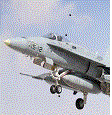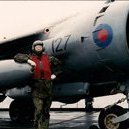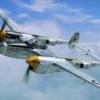Search the Community
Showing results for tags '148'.
-
Hello, this is my ongoing project: An F-14D Super Tomcat in flight, probably in take off phase. Here is what the project is like now And I would like to share the whole project from the beginning.
-
Fairey Firefly FR.1 Trumpeter 1:48 The Fairey Firefly was a British Second World War-era carrier-borne fighter aircraft and anti-submarine aircraft of the Fleet Air Arm (FAA). Designed to the contemporary FAA concept of a two-seat fleet reconnaissance/fighter, the pilot and navigator/weapons officer were housed in separate stations. It was superior in performance and firepower to its predecessor, the Fulmar, but entered operational service only towards the end of the war when it was no longer competitive as a fighter. The limitations of a single engine in a heavy airframe reduced its performance, but it proved to be sturdy, long-ranged, and docile in carrier operations. The Model The Fairey Firefly Mk.1 has been kitted many times by AZ Models in 1:48, but they have really been short run kits and while very nice, were not easy to build for the less experienced modeller. Now, Trumpeter have thrown their hat into the ring with this release of the Mk.1. The kit comes in a nice top opening box with an artists impression of the aircraft in flight on the top. Inside there are six sprues of grey styrene, one of clear a small sheet of etched brass and a decal sheet. This will certainly be an easier build for the average modeller, unfortunately, like the Sea Vixen in the same scale from Trumpeter it does have some, ok, quite a few detail problems. Working back from the nose, the spinner is a tad too pointy, the chin mounted radiator faring isn’t wide enough and the panel behind it too wide, the chin intake far too deep to the mesh grille, the oil cooler intakes don’t have any detail on them and the intakes under them are not very well represented, the intake lip should be at a light angle, whereas it’s straight on the kit. The fuselage is missing many bumps, intakes and other minutiae, while some of the panel lines actually match the real aircraft; the majority are a figment of the imagination. The pilots canopy is quite nicely done, with the blown areas correct, but it’s not long enough, as it doesn’t include the rear strip that is prominent over the fuselage spine. Not that it matters that much as you cannot open the canopy anyway as Trumpeter have made it flush with the fuselage. The interior is more the designers imagination than to any relation the real thing, in both cockpits. Moving to the tailplane and the model gets worse. The shape of the rudder is completely wrong and the kit rudder looks like it’s made of stressed metal, not fabric. Since the rudder is the wrong shape, naturally the fin is also wrong and also with spurious panel lines, and don’t get me started on the horizontal tailplane. Totally wrong shaped elevators, and consequently totally wrong shaped tailplane. Ok, some good news, the main undercarriage legs look ok, although the oleos look like they have no weight on them, so you might want to cut them down. The wheels are rubbish, with no depth to them and rather than what we would call spoked, they look like dished, the tread pattern is a little too soft on the tyres too. The undercarriage bays give a half hearted attempt at detail, and it looks like someone has tried, but the stringers are ribs are too flat and the wrong shape, while the outer bays don’t have any angles other than 90’. Whilst we’re under the aircraft the flaps are the wrong shape, bays not deep enough and the inner bays look like they’ve been plated over rather than being able to see all the pipework that’s in there. At least the modeller won’t have to worry about the wing-fold detail as you can’t build the model with wings folded. For those of you that are still here reading this, I will go through the build as per normal. Construction starts with the front cockpit, with the two sides, rear bulkhead, instrument panel and joystick. The rear cockpit is larger but of similar build with the addition of the shoulder height shelf and a couple of radio boxes. These assemblies are then glued into one half of the fuselage, along with the chin radiator which has been fitted with a PE grille to the rear. The propeller is then assembled from the boss, three blades, spinner and rear cap, which is sandwiched between the fuselage sides as they are glued together. The under fuselage radiator outlet si also fitted with a PE grille and fitted aft of the chin radiator panel, while the side oil cooler intakes are also glued into position. The wings consist of a single piece lower section and two upper sections between these are fitted the main undercarriage bays. The ailerons, cannon fairings, flap actuators, pylons and landing light lens are attached to the wing assembly before the whole assembly is glued to the fuselage. The main undercarriage is assembled, each side being made up from five parts before being fitted to their respective bays. The main gear bay doors are then attached and the flaps fitted. The kit comes with a choice of weapons to hang under the wings, two 500lb bombs and four rockets per side, in twin vertical arrangement. The tail wheel is then fitted along with the arrestor hook. The horizontal tailplane comes in upper and lower halves and single piece elevators; the assembly is then glued to the rear fuselage, followed by the two piece fin and two piece rudder. The windscreen and canopies are then fitted, followed by the exhaust stubs. Decals The largish decal sheet contains markings for four aircraft, it appears to be well printed, in register and opaque, they are also very glossy. Carrier film is fairly thin, so should take softening and setting solutions well. For those who don’t like painting the black and white identification stripes, these have been provided on the sheet. The aircraft included on the painting guide are:_ Firefly FR.1 DK477 of the Fleet Air Arm, 766Sqn, based at RNAS Lossiemouth 1949 Firefly FR.1 281, PP433 of the Fleet Air Arm, on board HMS Triumph, Far East Fleet 1950 Firefly FR.1 Z1832 of the A&AEE, Boscombe Down, during prototype trials, July-August 1943 Firefly FR.1 277, DK438, 1771Sqn. Fleet Air Arm, based on board HMS Implacable 1945. Conclusion As some will know, I am ex-FAA as is my Father, therefore I have a great interest in FAA aircraft, the Firefly being one of my favourites, so it is a great pity that once again Trumpeter have taken a wonderful British aircraft, matched it with their complete lack of proper research and ruined what could have been a very nice kit. Yes it will build nicely, yes it sort of looks like a Firefly FR.1, and if those are the standards you build by, then that’s fine, it’s your hobby, but for me this will be consigned to some other use, and I will stick with my AZ kits. Review sample courtesy o UK Distributors for
-
My Revell 1/48 Ju52 , Been wanting to do a Ju52 for a while.The nose art is all original work so dont look to far into it , also the markings are probably wrong ,but its what i had so i went with it , i tend to do kits to what i like , so if you are expecting 100% originality not the place for you here lol hope you all like and feel free to leave comments good and bad , am a big boy i can take it lol , (ps here is a small WIP if intrested http://www.britmodeller.com/forums/index.php?/topic/234963014-ju52-revell-148/ )
- 23 replies
-
- 8
-






